Joshua and I have a little apartment attached to our collegiate institute. We really like the idea of having a garden and being able to grow our own food. Of course, having a cement deck does not really help our plight. When my mom came to visit in May, she helped me get the ball rolling with getting plants and seeds in the pots and helped me get a system going.
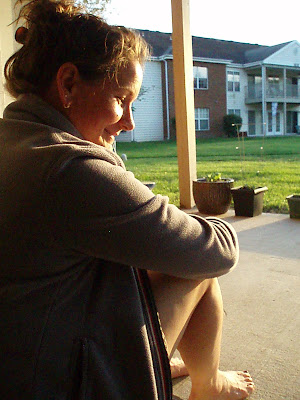
It's been almost two months now and I thought it was definitely high time to show the progress that has been made. Here's our little cement-deck shot. We live facing a youth sized soccer field that is encircled by Virginia's favorite tree: the Crape-myrtle.
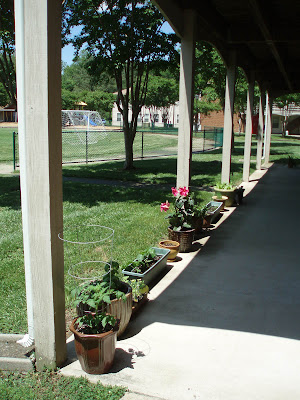
Already planted at this time (early June) were our tomatoes, herbs: (Italian basil, oregano, chive, sage, mint), lettuce, cucumbers and seeds were in the ground for our spinach, dill, peas and radishes.

I don't think I've ever gotten anything to grow
successfully from seeds and these little beans were giving me some serious hope for my future as a green thumb. I bought these seeds from the farmer's market from a local farm and I was so tickled when they started sprouting early! Two weeks later, my beans were looking for somewhere to grow:

Somewhere in those two weeks, I was feeling pretty good about seeds, so I also planted Italian flat-leaf parsley. Such sweet little green blooms of life:
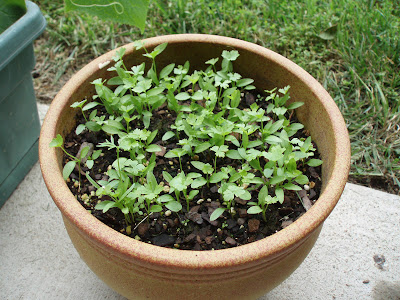
My mom planted my cherry tomato plant when she visited in May and it has done nothing but flourish. I put it at the end of my walkway and it gets excellent amounts of sun in the morning and throughout the day. I have neighbors who planted inverted tomato pots (I'm still not keen on the idea) and had a rocky start with it, but have finally started forming fruit. I've already been harvesting mine for a couple of weeks. Check out the growth on these tomatoes:

After two weeks, it had already grown over the top of the tomato stake and was looking for more room to grow.

Then one morning after my walk I noticed it was full of blossoms and one tiny little green tomato! I was so tickled, I had to take a photo for posterity.
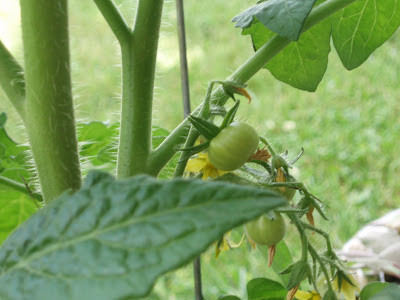
No sooner have I uploaded the photos from my camera when I find that my tomato plant is really growing and I have a beautiful cluster of fruit beginning to ripen!
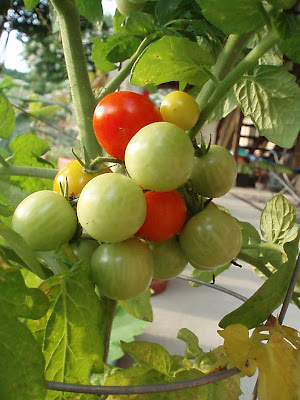
One week at
the farmer's market I noticed they were selling plants, of which I had already planted most of the basics, but I saw they were offering lettuce. I had sown seed for spinach and a spring mix, but I thought perhaps this "deer-tongue" variety might be fun to try. The six-pack of lettuce plants was being sold for $1.50, so I figured if it bombed, I didn't lose much. They were looking a little tender and I was rather
apprehensive whether I thought they would actually take root, but about a week later, I was already harvesting leaves for
sandwiches and to accompany salads.

Shortly thereafter... they really started to take off. I went on a trip for two weeks and a couple of my plants died from the heartbreak of my absence, but the lettuce plants that did survive did really well. Also, the spring mix of
micro greens I planted by seed in the center of the pot were progressing way beyond my meager expectation of my cement garden.
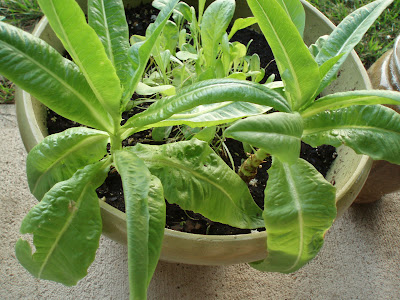
Below is the photo I took this evening of my crazy lettuce plants. Yes, they have gone to seed because I can't harvest their sweet leaves fast enough. I'm hoping to dry out the seeds after it goes wild so I can try my hand at deer-tongue lettuce again. It was such a wonderfully mild lettuce and for our climate and sun, grew extremely well.

The cucumber starter plants I bought I thought would never reach maturity...

...but those words were barely out of my mouth, when my
cukes were already reaching out of the box. I quickly learned that cucumbers have really extensive root systems that bury themselves at least 18" and I needed to transplant even though they had already begun to flower.
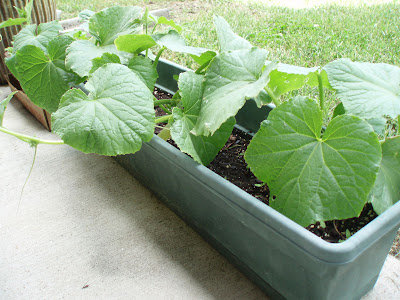
The transplant was a success and my plants were quickly covered in pretty yellow blossoms and fantastic looking
cukes!
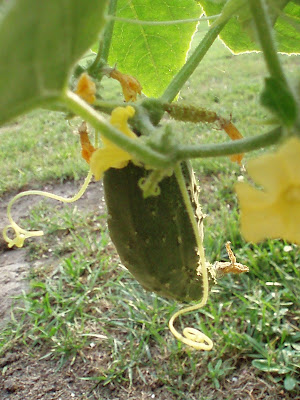
As far as herbs are concerned, my oregano, chives and rosemary came back from the years' prior, and we purchased starter plants for the Italian basil, purple sage and grew parsley from seed. Now isn't that a fantastic looking herb pot?
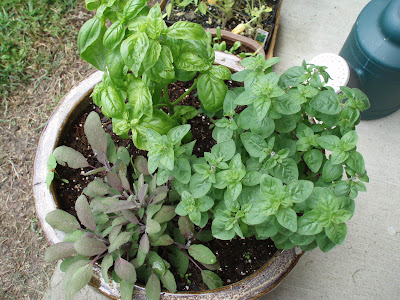
I have this special love for Kentucky Colonel spearmint. Just after I got married, my dad had a layover in Norfolk before he flew to Iraq and as my own husband was deployed elsewhere, I had this really special daughter-daddy time where I made him lots of fresh mint iced tea. Somehow I always associate bright, fresh, huge Kentucky Colonel mint leaves with that memory and I love having it on hand in case he should happen to drop in, I have plenty on reserve for him!

This is my purple-leaved sage as of tonight. Joshua and I really enjoy frying sage leaves as a fantastic amuse-
bouche styled appetizer. It's so remarkably fresh and clean on the palate and it's rather unexpected... I can't wait to preserve it for the winter and have on hand for our
Thanksgiving turkey. For as long as I can remember, my mom has put sage leaves under the skin of the turkey with stems of chives, to look like growing plants under the skin... it makes a wonderful
presentation after the bird is browned.
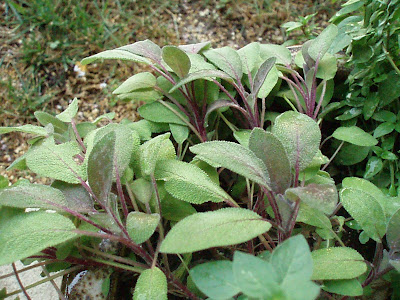
This is my sweetie rosemary plant. I've had the same plant now for three years and though it never seems to get amazingly large, it has been very resilient to the changes (4 different pots, 3 different locations, droughts, floods...). Rosemary is most certainly Joshua's favorite plant in our garden (just ask our friends), so I make sure to take extra care with this plant!
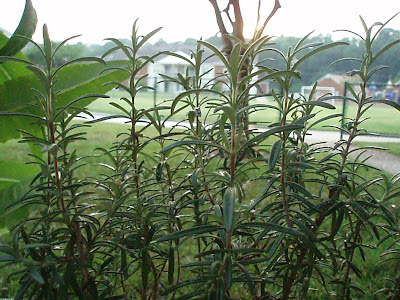
We planted zucchini and
Brussels sprouts as well this year. I think they got a late start and were not potted in enough soil (part of the drawback of having to put everything on a cement deck), they both are rather floundering this year and though the zucchini continues to produce gorgeous orange blossoms, I have yet to see fruit.
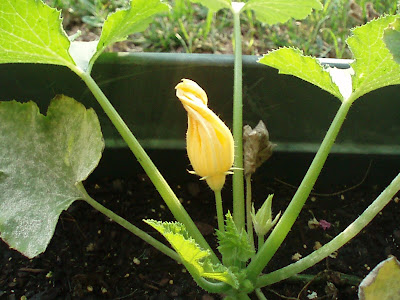
We also planted bell peppers and
jalapenos. The
jalapenos blossomed and produced fruit first and are almost ready for an initial harvest, which tickles me because I have a great recipe for preserved peppers that I'm dying to try out!

Speaking of preserving, after my cucumbers were done, I
transplanted my Italian basil to the
cuke pot and they have really dug deep and grown large enough to start me thinking about
caprese salad and pesto!
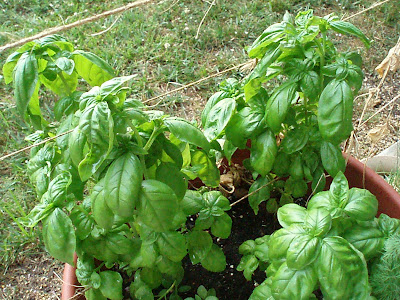
Of course no garden is complete without it's wildlife and
Aoife and I have been able to see many stunning butterflies, moths and dragonflies frequent our garden space. But this one takes the cake. I only saw it once climbing on my tomato pot and then I didn't see it again (I'm sure
metamorphosis is to take credit for that), but I still have no idea what it is. Any clues?

The
dipledenia I killed from last year was replaced with this gorgeous beauty which I can see from my kitchen and I absolutely love. My mom and I have this kindred
relationship for
dipledenia and I don't remember ever not having one... the climbing aspect of this flowering shrub just captivates me.

I have so many blossoms on it now it has been such a refreshing scent on my porch and a wonderful spray of pink for the Davis ladies who desperately need something
girly!
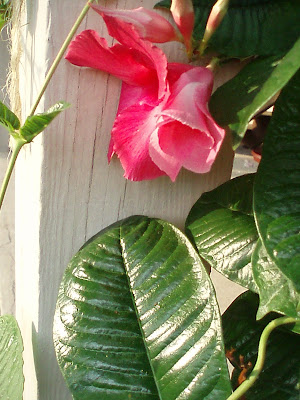
Thanks for sitting with us on our porch... if you stay awhile, I'll be sure to mix up a tall frosty glass of rosemary lemonade or minty iced tea!













